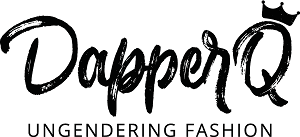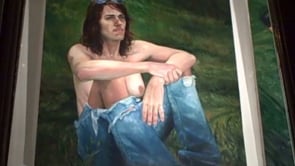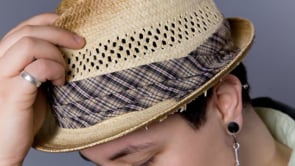In the process of creating a roadmap that dapperQ will use to advance the cause of those “transgressing men’s fashion,” I am drafting wide-ranging content that states a collective case, defines options, and advances change. This first piece seeks to identify our top challenges. I am not wed to the order, the language, nor the ideas. I am well aware of the limitations of my perspective as a 47-year old white, butch, Texan, and can only beg your input. It will be revised based on your feedback.
1. Internalized homophobia. The world says girls should act like girls and when we don’t, a lot of folks get angry. Few are those who affirm us. It’s hard to worry about the nuances of your fashion decisions when self-esteem is constantly battered by the masses.
2. Limited options. Fact is, men’s clothes don’t fit our bodies. Fit is one of the most important elements of style and we’ve rarely had the option of buying clothes that do.
3. Psychic discomfort. Whether we experience gender dysphoria or self-loathing because we are too tall/short/big/little, dressing can be a reminder of challenging realities.
4. Unwelcoming marketplace. Fact is, most department stores don’t want our business. Either sales people treat us poorly or they fail to offer to help. Many department stores insist that we go to the women’s department to try on clothes. (Can you send down to floor below for a size 15 ½ x 33 with the taupe pinstripe?)
5. Stilted family tradition. Our fathers and uncles didn’t want to or simply didn’t think to teach us. While taste may be inborn, fashion sense is acquired. Rare are those male elders who have shared the ways that they adapt fashion to richly align with cultural, ethnic and class traditions.
6. Outdated maps. Style guides abound for the man who wants to dress fashionably. They are augmented by gorgeous ads in glossy mags whose websites feature an increasing wealth of resources. We are stranded in what one dapperQ reader called a “sartorial wasteland.”
7. Rare role models. WE ARE LARGELY INVISBLE. The mainstream does not enjoy seeing us. Lesbian magazines predominantly feature woman who wear women’s clothes. None of them are Andre 3000. Even if your sense of style aligns with one of a handful of celesbian dapperQ’s, you would be hard-pressed to know how they do what they do.
8. Bigger fish to fry. Implications for suiting up as a gender rebel can range from job and housing discrimination to street violence to death. Those who escape these fates are often far too busy fighting within the social justice movement or raising good kids to worry about how they dress.
9. Little societal affirmation. What’s the motivation if rare is the glance that rewards?
10. Unwoven community. We are a tribe that was cast to the winds before we met. In the past decade, what I call a “transgenderational” divide has emerged between the elders and those that must follow. It is we who must help each other suit up to fight the good fight.
Feel free to leave comments below or e-mail me ([email protected]) If you would like to start from scratch with your own version (so long as it is written in accessible language and inspires rather than snarks.) I would love to publish alternatives. The next document will be: Top 10 Rewards. I also welcome your suggestions for formats that might more productively incorporate feedback i.e. wikis, forums, teleconference calls. Til soon, I hope…




This is a great list. I just started reading and I’m really excited about the whole DapperQ project. 🙂
Thanks for starting the conversation. As a small bodied, curvy, soft butch with a penchant for mary janes, I struggle with finding a place that makes sense for me, both in terms of fashion and in terms of acceptance. I’ve got to think more on this but really appreciate you framing this all out.
Warmly,
Jenn
Love this. Can you add as one of your challenges “little money”? I’m broke! Thrift stores work I am learning to sew but . . I am far from being able to see an outfit I like and then go out and buy that outfit.
In addition to featuring cool outfits, we need discussion of core principles and the elements of dapper style in order to make it accessible for everyone.
I don’t have much to add. You’ve done a brilliant job of covering all the bases on this one. I certainly struggle with item # 1 on the list.
I have endless rewarding glances to offer.
I think that sums things up really well, I think my biggest hurdles are size (short and curvy) and lack of rolemodels. Not being raised wearing the clothes I choose to wear now is hard I think, but I was never taught how things should fit properly. Now, I’m not saying that we all should wear things how we’re taught, but it’s nice to know how long a sleeve should come on an arm, or how a collar is supposed to fit
Rolled up sleeves and tucked in button downs with vests is how I generally go about working around the size issue (it’s easier to hand alter a vest than a whole shirt). Another big issue for me is how I see my body, and how I would like it to be. Am I ok with my boobs? I don’t like them in clothes, but am not uncomfortable with there existence in general. It’s generally disheartening that the clothes I would like to wear won’t look the way I want because I have a female body, even if I’m binding, my body is still going to be curvier than a male’s (hips, ass). It’s unsettling thinking (knowing) that my body won’t portray the style I want.
In regards to the money factor, I think that it definitely helps to have some. It also helps to have time. But money makes it way easier (though some of my best finds have been free or really really marked down).
In addition to the economics issue – of course high style requires not merely taste but the combination of cash, time, and luck – I’d say we also need to discuss finding and nurturing allies from outside our immediate communities. Fashion has been very hard hit by the world economic crisis, and they’re not in any position to ignore customers. This is a great time to both make new contacts, and also demand what we need – or take our business elsewhere.
Jenny Shimura (or Rachel Maddow) doesn’t have to be unique. Designers and tailors from smaller houses, fashion students, and more remote (from NYC-Paris-Berlin-Milan-Tokyo) locations DO want to design masculine tailoring for women’s bodies. Designers DO want to show menswear on atypical models – I’ve done runway work in Seattle, Vancouver BC, and SF, and I’m short and round (40XS x 35W x 27L)
~~~~~~~~~~~~~~~~~~~~~~~~~~~~~
Speaking of service and prices; I rarely have my alterations done at the store unless I just need the cuffs shortened in a hurry. Most medium and large cities in North America have tailors who work in the black and other ethnic communities, many of whom have experience fitting bodies outside the Anglo-Saxon norm AND have reasonable prices.
My current favorite tailor is Vietnamese (Adam Tailor, multiple Seattle locations), and my hatmaker is a locally legendary Afro-American, Mr. Conley (http://www.halcyon.com/hatter/). I buy (and sell) many of my better suits at Gentlemen’s Consignment. All give me excellent service, though not in a hurry by NYC standards.
~~~~~~~~~~~~~~~~~~~~~~~~~~
A related topic will be what to do when the service is poor or inappropriate. Strategies for prevention, tips for damage control, success stories… I know I’ve gotten amazing recourse when I contacted corporate HQ for the big box stores such as Macy’s, Men’s Wearhouse, and Sears. I’ve never had more than the usual fashion retail hauteur at the high end shops (Nordstrom, Barney’s, John Varvatos and others, various local menswear stores), so I suppose I would first talk to the department manager or store manager, and take it to HQ if they couldn’t make it good.
But then I’m light-skinned, English is my first language, professional, and in my late 40s. Privileged in many ways, and my retail experiences reflect that. As a political activist, though, I’m not willing to settle for being a 2nd class demographic.
Also – Fitting in as a transmasculine person who likes men. The straight ones freak, the gay ones think you’re a girl.